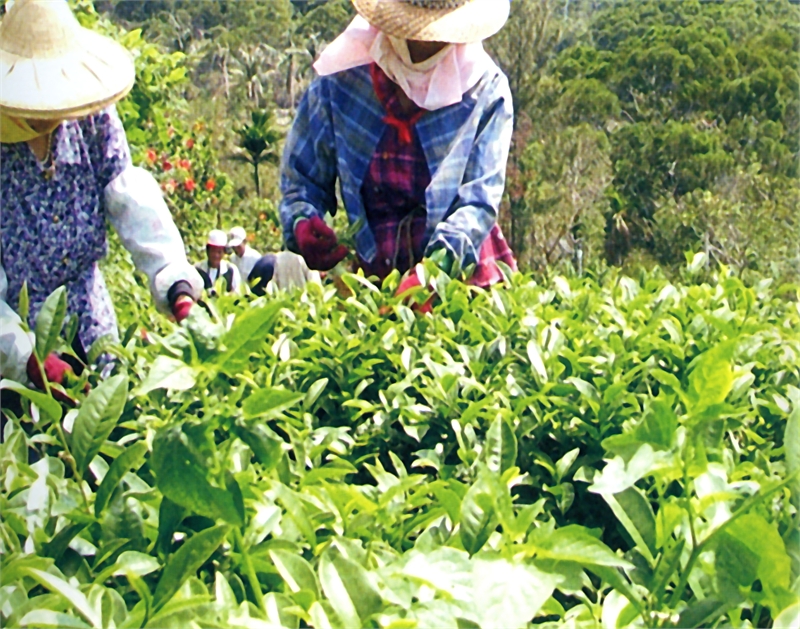Hengchun Three Treasures Introduction
In the past, the three treasures of Hengchun were "Qiongma, onions, and port tea," while today they are "Qiongma, onions, and watermelon." With the changing times, watermelon and onions remain the primary agricultural products of the Hengchun Peninsula. However, Qiongma has gradually declined due to industrial changes in Taiwan, and now only the "Qiongma Industrial History Museum" remains, allowing visitors to understand the rise and fall of Qiongma and serving as a testament to the once-thriving Qiongma industry. Qiongma: Among the three treasures of Hengchun, Qiongma is the most well-known and historically significant. Taiwan's Qiongma was introduced by American consul Davidson, initially experimented at the Taipei Agricultural Experiment Station, and later transplanted to the Hengchun Tropical Breeding Station. Due to successful trial cultivation, large-scale planting began; in 1918, machinery was imported, further mechanizing Qiongma production. The uses of the fiber are diverse, including ropes, hammocks, sacks, shoes, mattresses, carpets, brushes, and paper, even serving as packaging materials in farms and factories. With promising prices, residents of Hengchun rushed to the mountains, clearing forests and planting Qiongma seedlings on all available land. At its peak, production reached 200 tons in a month, earning the nickname "The Light of the East." At times when Qiongma prices were highest, it surged to NT$12 per kilogram, leading Hengchun residents to accumulate significant wealth, reflected in the local saying "Qiongma fibers lead to tall buildings," thus establishing Qiongma as a symbol of Hengchun. Later, with the rise of industry and fierce international market competition, prices plummeted, and the profits from cultivating Qiongma became negligible. This marked the decline of Qiongma in Hengchun, and it wasn't until tourism began to rise again that the villagers shifted their enthusiasm from cultivating Qiongma to engaging in the tourism industry. Onions: The barren gravel soil of the Hengchun Peninsula and the strong winter "mountain wind" are suitable for onion bulb growth. The stronger the mountain wind, the better the quality of the onions. After importing over 30 varieties from the United States in the 1950s, Hengchun became the primary onion-producing area in Taiwan, even accounting for 80% of Japan's total onion imports in the 1970s. During the peak production season in March and April, golden onions can be seen piled by the roadside sparkling in the sun. To market onions, the Checheng Rural Association combines tourism to hold the "Hengchun Onion Festival/Carnival." It also develops many onion by-products, making onions a representative specialty of Pingtung County. Port tea: Produced in Gangkou Village of Manzhou Township, located at the mouth of Gangkou Creek, it is said that during the Guangxu years of the Qing Dynasty, the county magistrate enjoyed drinking tea. However, there were no tea trees on the Hengchun Peninsula, so fresh tea was unavailable. Tea seeds were then purchased from Anxi, Fujian, for experimental planting in Hengchun and Manzhou. Successful cultivation occurred in Gangkou Village due to its sloped land sheltered from the northeastern monsoon and favored by the southwestern monsoon, receiving abundant rainfall, making it ideal for tea cultivation, thus it was named Port Tea. Port tea is mostly planted on sloped terraced fields, with a production season year-round. However, the cultivation area is very small, with an annual output of about 600 kilograms. It is pricey, especially spring and winter teas. Due to its limited production, it can only be purchased at tea shops within Hengchun Town. The biggest features of Port tea, influenced by the climate and soil, are its strong bitterness, high concentration, and longevity of flavor, along with its rich aroma, leaving a lasting aftertaste. Its unique taste is rumored to have miraculous effects in treating coughs and colds when consumed with rock sugar, and it has become one of the specialties of Kenting National Park. Watermelon: In recent years, watermelon has been planted along the riverbeds of Shou Chung Creek and Fenggang Creek in the Hengchun Peninsula, taking advantage of the winter mountain wind season. It is the only place in Taiwan that produces watermelon in winter. The red watermelon flesh is as vibrant as the hot sun of the Hengchun Peninsula, and the local watermelons are sweet, crisp, and juicy, with excellent texture. As a result, watermelon is gradually replacing port tea among the three treasures of Hengchun.
 Harbor Tea
Harbor Tea
 Qiongma Industrial History Exhibition Area
Qiongma Industrial History Exhibition Area



































